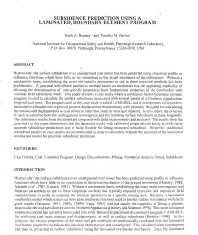Mining Publication: Subsidence Prediction Using a Laminated, Boundary-Element Program
Original creation date: June 1998
Historically, the surface subsidence over underground coal mines has been predicted using empirical profile or influence functions which have little or no connection to the actual mechanics of the subsidence. Without a mechanistic basis, establishing the exact site-specific parameters to use in these empirical methods has been problematic. A practical subsidence predictive method based on mechanics has the appealing capability of allowing the determination of site-specific parameters from fundamental properties of the overburden with minimal field calibration work. This paper presents a case study where a mechanics-based, boundary-element program is used to calculate the surface subsidence associated with several panels of a Northern Appalachian longwall coal mine. The program used in this case study is called LAMODEL, and it incorporates a frictionless, laminated overburden into a general purpose displacement-discontinuity code primarily designed for calculating the stresses and displacements in coal mines or other thin seam or vein type deposits. In this paper, the program is used to calculate both the underground convergence and the resulting surface subsidence at three longwalls. The subsidence results from the model are compared with field measurements and analyzed. The results from the case study in this paper demonstrate that the laminated model with calibrated properties can easily provide fairly accurate subsidence predictions and is fairly flexible for fitting measured subsidence. However, additional subsidence predictive case studies are recommended in order to ultimately evaluate the potential of the laminated overburden model for practical subsidence prediction.
Authors: KA Heasley, TM Barton
Conference Paper - June 1998
International Journal of Rock Mechanics and Mining Science, NARMS 98 - 3rd North American Rock Mechanics Symposium, Cancun, Mexico 1998 Jun/July, 35(4/5), Paper number USA-907 :381-390
See Also
- Analysis and Design Considerations for Superimposed Longwall Gate Roads
- Degasification System Selection for U.S. Longwall Mines Using an Expert Classification System
- Development of Stress Measurements and Instrument Placement Techniques for Longwall Coal
- Horizontal Stress and Longwall Headgate Ground Control
- MCP - Methane Control and Prediction - 2.0
- Modeling and Prediction of Ventilation Methane Emissions of U.S. Longwall Mines Using Supervised Artificial Neural Networks
- Modeling the Effects of Longwall Mining on the Ground Water System
- Overview of Coal Mine Ground Control Issues in the Illinois Basin
- Reservoir Engineering Considerations for Coal Seam Degasification and Methane Control in Underground Mines
- Timing and Duration of Subsidence Due to Longwall Mining
- Page last reviewed: 9/21/2012
- Page last updated: 9/21/2012
- Content source: National Institute for Occupational Safety and Health, Mining Program


 ShareCompartir
ShareCompartir
